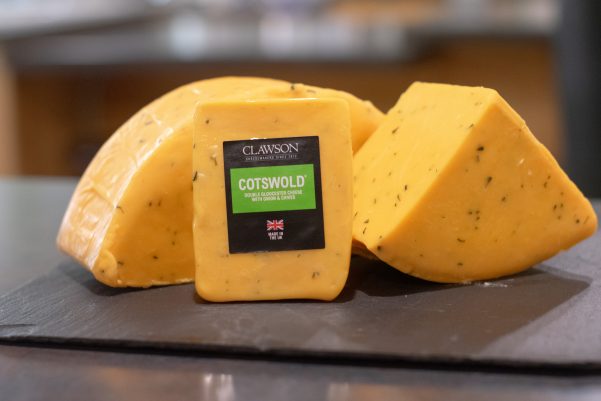Cheese Madness

8 cheeses will go rind-to-rind in the Co-op’s bracket challenge!

Grand Prize: $75 MFC Gift Card!
Sample and vote in-store March 5-25
Thursdays & Fridays | 3:30-5:30pm
2025 Lineup
Deer Creek The Rattlesnake:
Spicy, sweet, tropical, hot — Deer Creek’s The Rattlesnake is a bold and flavorful specialty cheddar that packs a flavor punch. Infused with premium tequila to warm and open your palate, this creamy medium aged cheddar is smooth and sweet before it hits you with a burst of fiery habanero. Another Wisconsin cheesemaker, Deer Creek keeps it clean and simple — using fresh milk, salt, and enzymes with a “kick of whimsy” from fun, bold ingredients. The smooth, semi-firm texture of The Rattlesnake allows the cheese to melt beautifully, making it perfect for melting on burgers or nachos. For accompanying sips and nibbles, try it tropical fruit like pineapple or mango or with Mexican beer, iced sangria, or a classic margarita. With its smoky heat and complex flavors, this is an option for those not afraid of heat, or a sharp bite.
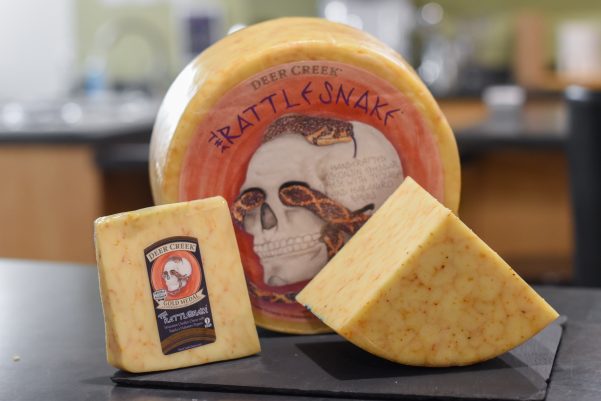
Carr Valley Apple Smoked Cheddar:
Carr Valley Apple Smoked Cheddar is a premium artisanal young cheddar that offers a perfect balance of sweetness from milk, light smoke, and subtle spice. Located in central Wisconsin, Carr Valley is family owned and has been in operation for over 100 years. Handcrafted using old-fashioned methods and milk sourced from small farms, this mild white cheddar is smoked with applewood, resulting in a distinct smoky aroma and depth. The rind is then hand-rubbed with paprika for a deep red color and added flavor. A moist, smooth, and creamy texture, this cheese melts beautifully. Whether enjoyed on its own, paired with fruits and crackers, or melted into dishes, it’s versatile and indulgent.
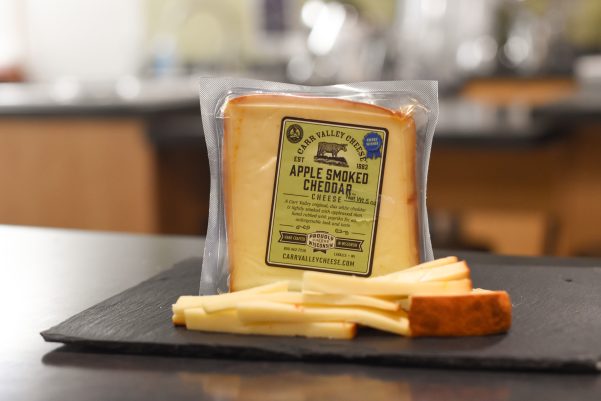
Sartori MontAmore:
Sartori MontAmore is a unique and flavorful gourmet white cheddar, inspired by traditional parmesan. The nutty flavor and crunchy crystals (calcium lactate) which form during the aging process provide a satisfying mouthfeel. Crafted from premium Wisconsin cow’s milk, this sweet and fruity cheese finishes with a tangy bite. Inspired by European tradition, it’s named for the Dolomite mountains that provide breathtaking views above the Sartori hometown of Valdastico, Italy. It’s the perfect charcuterie board star, pairing perfectly with crusty bread, green olives, nuts, fruit, and chocolate, as well as Chardonnay, Pinot Noir, IPAs and Stouts.
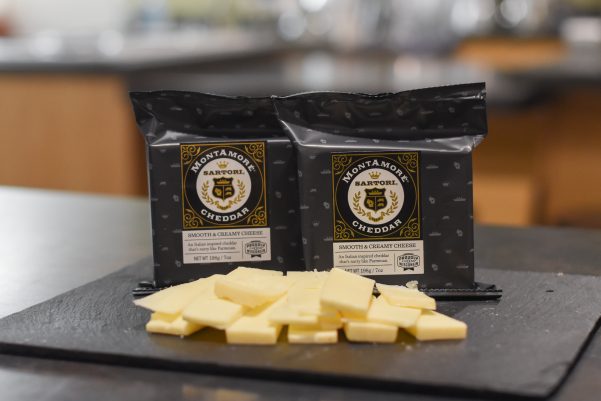
Jim’s Aged White Cheddar:
Wisconsin cheese from Wisconsin cows! Jim’s Cheese is a Wisconsin staple, distributing fine cheeses from its base in Waterloo since 1955. The Vintage Selects 3-Year Aged White Cheddar is a premium full-bodied cheese with a rich, sharp flavor and smooth, crumbly texture. Aged to perfection, this white cheddar is carefully crafted using traditional methods, allowing the natural flavors to develop over time — resulting in a robust taste with complex undertones. Enjoy this fan favorite white cheddar on its own or paired with crusty bread, tangy mustard, and prosciutto.
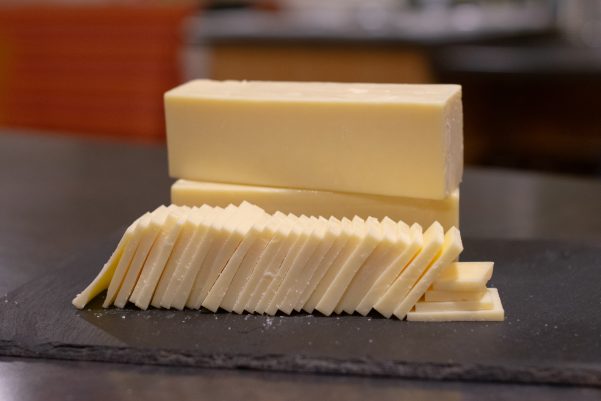
Kerrygold Dubliner:
Kerrygold is an Irish company with a long history of producing high-quality dairy products. The cheese is made from the milk of grass-fed cows, which contributes to its rich, creamy flavor. The use of traditional Irish cheesemaking techniques adds to the charm and appeal of the cheese. A mature, full-flavored cheese with a natural hint of sweetness, it has elements of a cheddar, the sweet nutty tones of a Swiss, and the piquant bite of an aged parmesan. Suitable for vegetarians, Dubliner can be used on a cheese board, in sandwiches, and in a range of recipes. Particularly delicious simply cut into cubes or sliced.
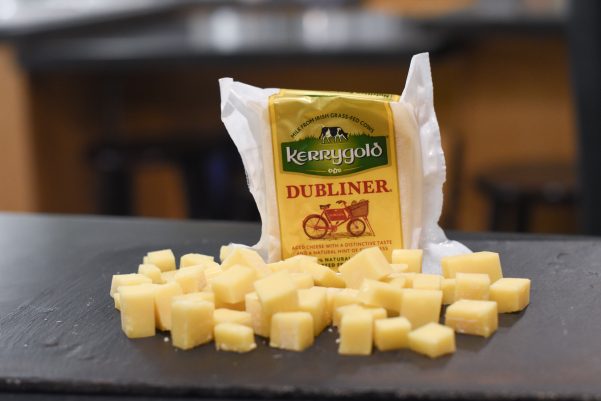
Tipperary Vintage Irish Cheddar:
The history of this cheddar can be traced back to the early 19th century, when Irish cheesemakers began to experiment with cheddar production techniques. The county of Tipperary has a long tradition of dairy farming and cheese production, with the region’s lush, green pastures providing ideal conditions for raising dairy cattle. Over time, the cheesemakers in Tipperary developed their own unique style of cheddar, which has become renowned for its depth of flavor and quality. This aged cheddar is a crowd-pleasing favorite; it pairs well with various foods and beverages, such as fruits, crackers or bread, charcuterie, Irish stouts or porters, and full-bodied red wines like Cabernet Sauvignon, Merlot, or Syrah. Try adding this cheddar to mashed potatoes or atop a shepherd’s pie.

Somerdale Red Dragon:
This English cheddar from Somerdale is buttery and spicy — plenty of bite, but not too hot. Wholegrain mustard seed gives Red Dragon it’s infamous taste and pleasant grainy texture, while brown Welsh ale makes it moist and tangy. This cheese, made from pasteurized cow’s milk, is aged 3 months and coated in red wax (hence the name). This creamy specialty cheddar is a great addition to any cheese board or adding an interesting texture and bite to grilled cheese sandwiches. Pair it with a full-bodied wine like Zinfandel or a brown ale to match the flavor in the cheese.
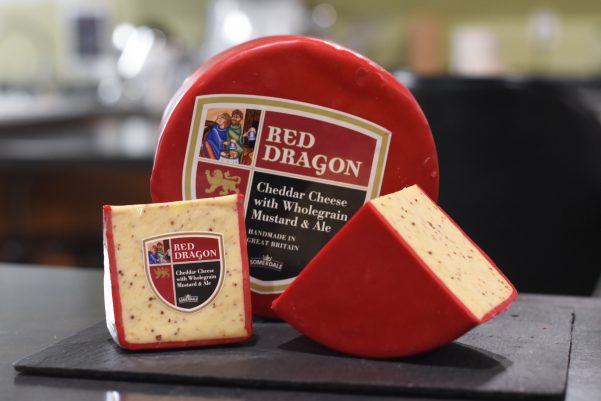
Clawson Cotswold Onion & Chive:
Clawson’s Cotswold is known for its bright, egg yolk-yellow color and distinctive, tangy flavor. Made from cows raised on lush pastures in the Cotswold region of South Central England, this savory cheddar is packed with a generous amount of chives and onions, giving it a gorgeous green speckling. Aged three months, the rich, fudgy texture against the sharpness of the added herbs results in a balanced, yet bold profile. Cotswold melts and crumbles well, making it a great choice for toasted sandwiches or burgers. Enjoy it with a pint of your favorite beer.
